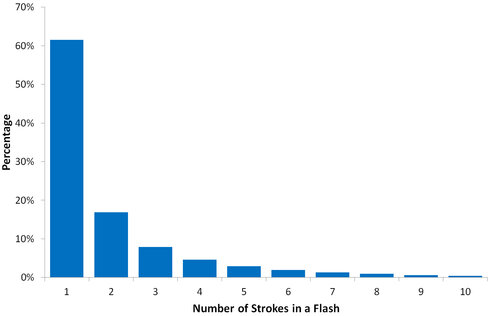Amplitudes

Lightning peak currents, as well as many other natural phenomena, are distributed approximately log-normal. This means that the frequency distribution of peak currents represents a normal distribution if the amplitude values are displayed on a x-axis with logarithmic scale. If the cumulative frequency of a log-normally distributed parameter is plotted in a graph with probability scale on the y-axis, the distribution follows a straight line.

| On a probability scaled cumulative distribution plot the ALDIS estimated peak currents show up as a nearly straight line with a median value of 10 kA. This confirms log-normal distribution of the peak currents of lightning discharges. The 50 % value (median) of 10 kA for negative flashes means that about half of all located ALDIS negative flashes had an amplitude of more than 10 kA. |

A very similar picture emerges for the positive flashes. Video studies in the US showed that part of the cloud-cloud discharges are misclassified as positive cloud-to-ground lightning of low amplitudes and therefore ALDIS classifies positive discharges with amplitudes less than 5 kA as cloud-cloud discharges.

Also the amplitudes of the positive flashes approximate a log-normal distribution.
The amplitudes of positive and negative flashes and of first and subsequent strokes differ only slightly in the ALDIS data. The data from the lightning detection system provides approximately the same median value of about 10 kA for positive and negative flashes. There are significant discrepancies between the data from lightning location systems and results from tower measurements in the 60ies and 70ies at the Monte San Salvatore (Switzerland). At the tower a median of 35 kA and 30 kA was determined for positive and negative lightning, respectively. The reasons for this discrepancy are not clear to date and this is a current topic of international lightning research activities.
Negative flashes with amplitudes greater than 100 kA are rarely located, whereas estimated amplitudes of located positive flashes are sometimes in the range from 200 kA to 300 kA and even more.